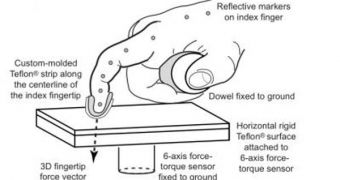Experts conducting experiments on the limits of the human hand's neuromuscular dexterity were puzzled to determine in their studies that even seemingly simple operations conducted with a single finger appeared to push the muscles to extremes. The find could have serious implications for the field of disability rehabilitation, as well as for future robotic arm designs, which attempt to replicate the human hand as accurately as possible at this point. The new investigation shows that this may not be such a good idea, and that robotics engineers should perhaps look for new sources of inspiration.
“Push your finger as hard as you can against the surface. Now as hard as you can but move it slowly – follow the ticking clock. Now faster. Now faster,” these were the commands that scientists from the University of Southern California (USC) gave test participants. The subjects had a close-fitting Teflon cover on their forefingers, and were asked to move them over a slippery Teflon surface linked to a force-measuring sensor. The results of their attempts even cast shadows of doubt on established ideas as to how the human hand functioned.
Expert Francisco Valero-Cuevas, the leader of the USC science team, adds that the results may hold clues as to why the hands are so vulnerable to aging and injuries, at least in terms of dexterity. The complete results of the investigation are published in the latest issue of the Journal of Neuroscience. The expert explains that physiological “force-velocity” properties are the main factors that limit muscle force, as well as their ability to move faster. “That is why your bicycle has gears, and why as a child you could not speed up much on level ground,” he says.
“As expected, maximal downward force diminished when motion was added to the task. But, remarkably, there were no significant differences (...) between slow, and fast movement speeds (...) even though the movement speeds varied 36-fold,” the experts write about their finger studies. The participants were asked to move their fingers over the surface, then press, and then move again at the beat of a metronome. The action became increasingly difficult as the beat was turned up.
“These apparently esoteric results have tremendous implications for both humans and robots. For one, they bring together basic research and clinical reality by helping explain the high vulnerability of dexterous everyday function to disease and injury in spite of the many muscles and joints we have. In addition, they suggest to engineers that adding redundant motors to robots may actually be the key to making them dexterous,” Valero-Cuevas concludes.

 14 DAY TRIAL //
14 DAY TRIAL //